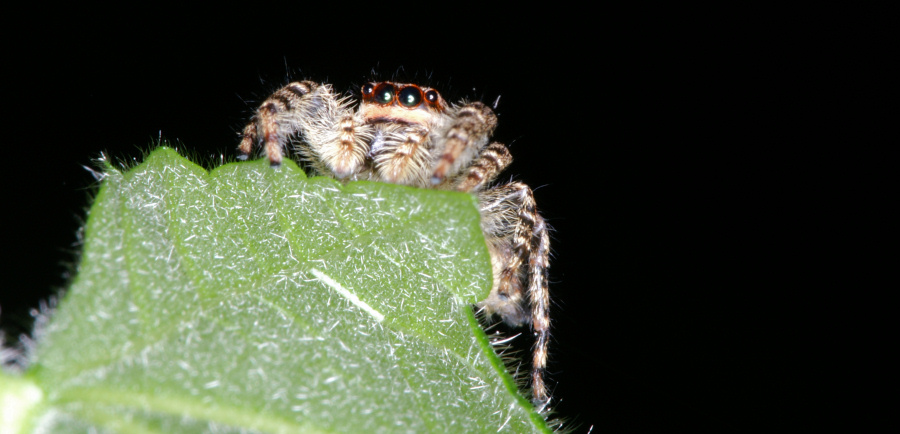

These are my favourite spiders.
When you have attracted their attention, they follow you with their big
eyes. They are friendly little creatures that always like to jump on your
camera or your fingers. |
|
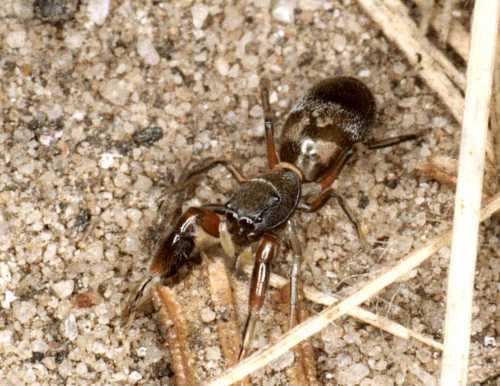 Ligonipes semitectus, ant mimicking spider from Australia |
Some species exhibit an amazing resemblance with ants and are called "ant like " spiders. They belong to the genus Myrmarachne. The one shown on the left was found in Australia. Because of its resemblance to ants, it can walk between them without being attacked. Salticids can be found everywhere if the sun is
shining, on trees, grass and rocks. At night or during rainfall the spiders
hide in a dry spot under a small web.
|
Prey can be noticed from a distance of about 30 - 40 cm. At a distance of 20 cm the spider turns its body so that the two front eyes points to the insect. The muscles in the eye focus the eye on the prey and the eye moves around their optical axis. In this way the spiders scans the object like a modern scanner. The effect is extraordinary. The eyesight is enhanced like a zoom lens and it is capable to adjust its looking angle from 10 to 60 degrees. In experiments it was shown that the spider is capable to distinct dangerous insects and prey. The eyes are also capable to see colour. After the object is recognized as eatable the spider carefully moves towards it victim As you can see the on the picture they also catch prey, much bigger than themselves. It was spectacular to see the little Salticus scenicus catching the big fly. Salticids are the tigers among spiders. The
spider slowly advances towards its prey. When it is at a reachable distance,
it jumps on its prey and grabs it with its jaws. They use their third and/or
fourth pair of legs for jumping. If you notice the spider on a wall, often
the Salticus scenicus,
it seems as mocks at gravity. It jumps of the walls and falls back on it
several centimeters further instead of falling down. This is because of its
lifeline. If you watch the spider carefully, you can notice that it always
releases a lifeline when it jumps. If the jump fails it can crawl back to
its original position and it prevents the spider from falling down.
For the American continent there is a large site dedicated to jumping spiders: Jumping spiders in America |
Salticus scenicus |
Genus Aelurillus
Only one species occurs in NW-Europe. Their size
varies between 4 and 7 mm.
The male has v-shaped rows of hairs on its head and
a pronounced white median stripe on its abdomen.
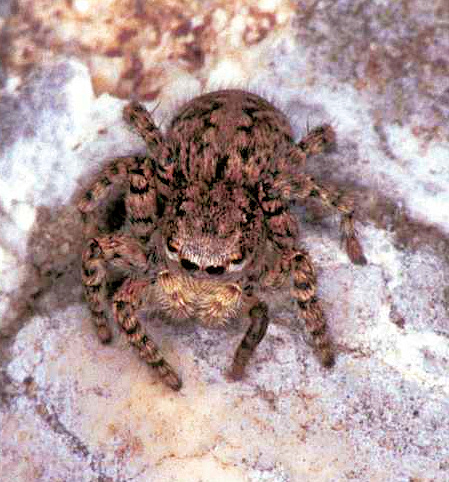 |
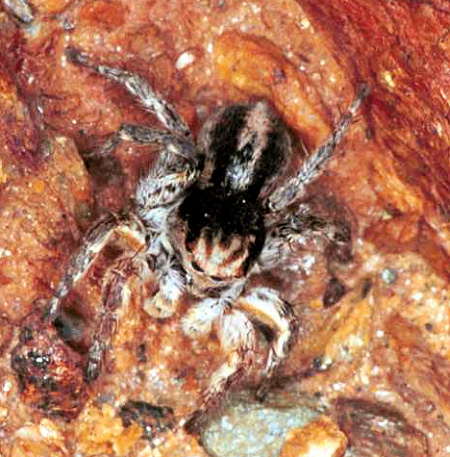 |
| Aelurillus v-insignitus female | Aelurillus v-insignitus male |
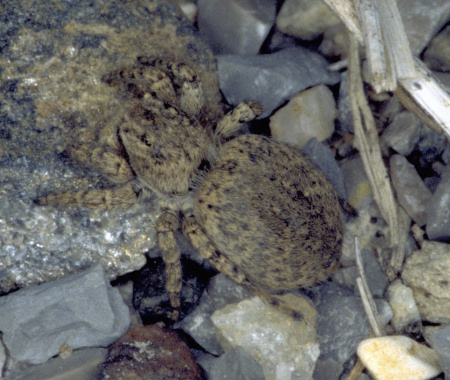 |
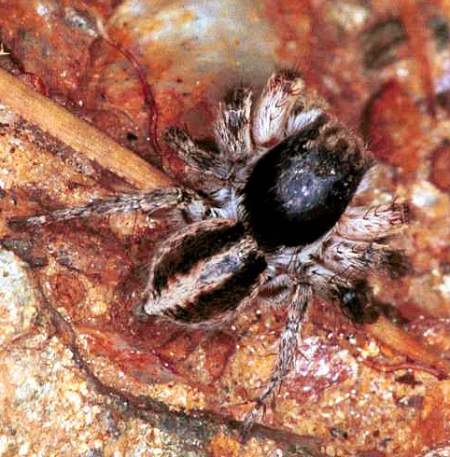 |
| Aelurillus v-insignitus female | Aelurillus v-insignitus male |
This small spider (3- 5 mm) can be found on
broad-leaved bushes and trees, particularly oaks and her common name is:
oak-leaf jumper
The spider sits on my stone washed jeans.
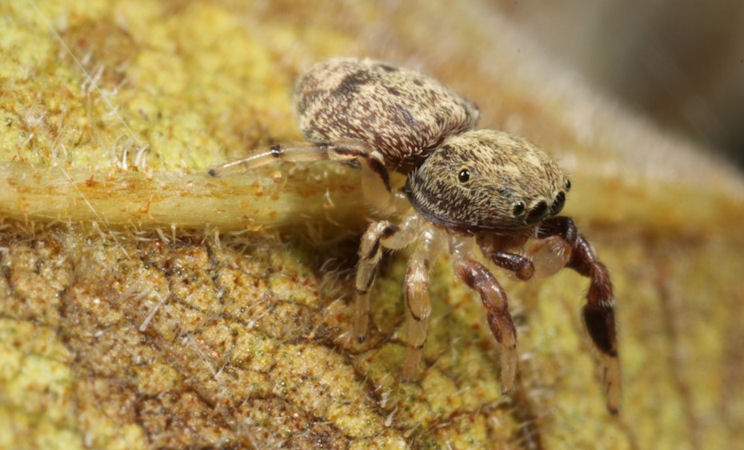 |
|
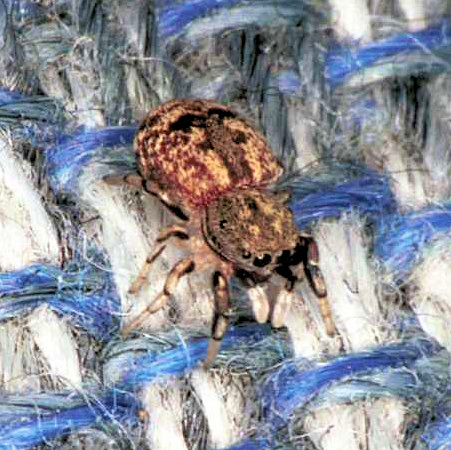 |
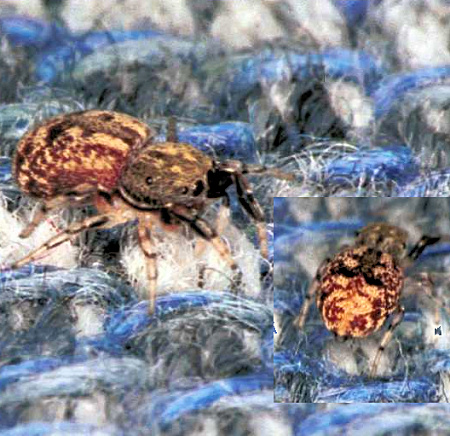 |
| Ballus chalybeius | Ballus chalybeius |
Genus Bianor
Only one species can be found in our regions. The
spider is small with a size between 3 and 4 mm.
The male spider can be easily recognized by his
swollen fore legs.
|
|
|
|
Bianor aurocinctus female |
The male and female of these species are so
differently coloured that they were long denoted as different species. The male
has a black head while the female's head has yellow-orange spots. Her body is
beautifully coloured with orange and yellow hairs.
The spider can be spotted bushes in the southern
parts of Europe. The species is very rare and therefor endangered.
|
|
|
|
Carrhotus xanthogramma male |
Carrhotus xanthogramma female |
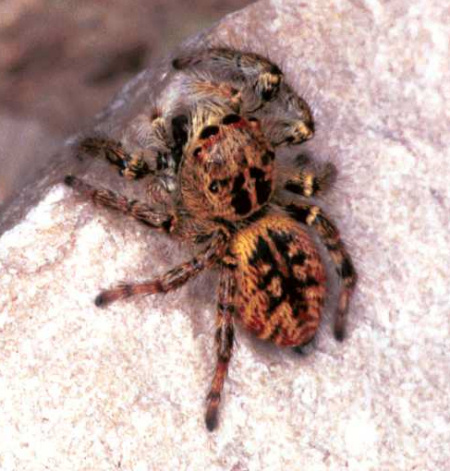 |
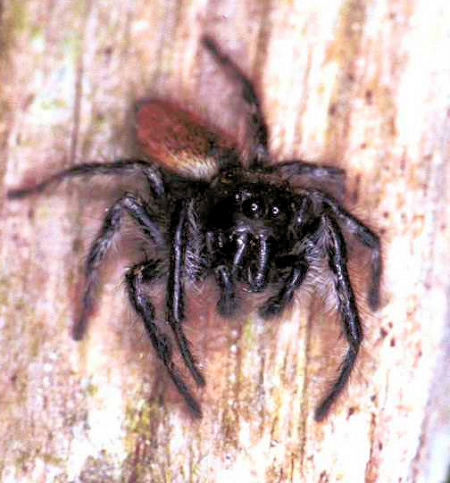 |
| Carrhotus xanthogramma female | Carrhotus xanthogramma male |
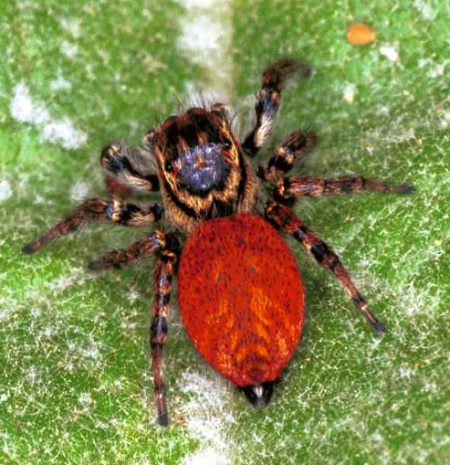 |
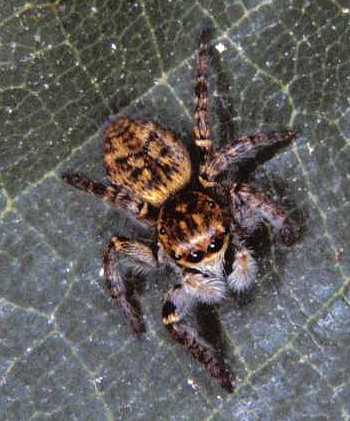 |
| Carrhotus xanthogramma female | Carrhotus xanthogramma female |
Genus Cyrba
This beautiful spider can be found in the southern part of NW-Europe
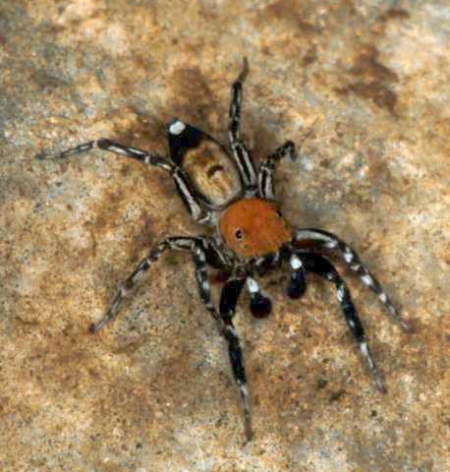 |
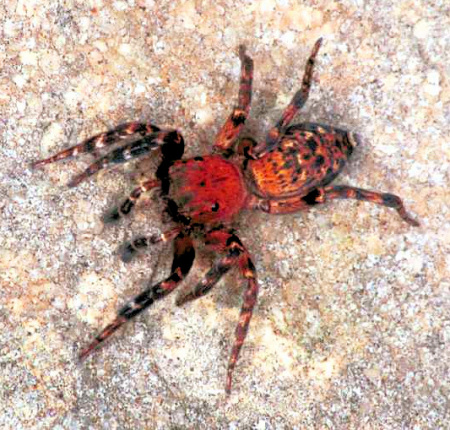 |
| Cyrba algerina male | Cyrba algerina female |
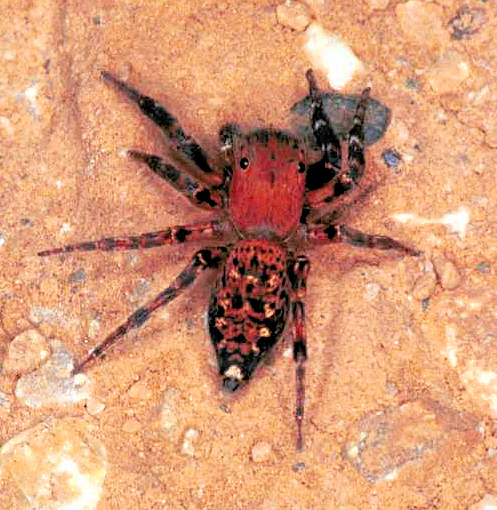 |
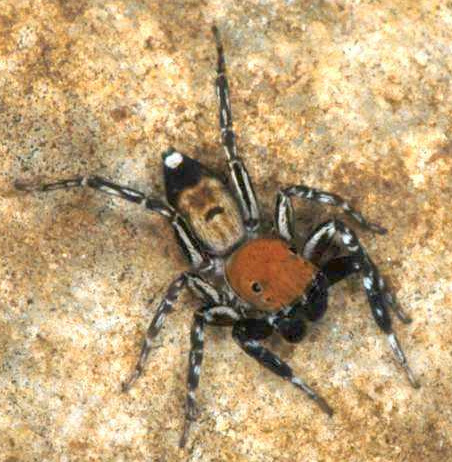 |
| Cyrba algerina female | Cyrba algerina male |
Genus Euophrys and Pseudeuophrys
The spiders belonging to this genus are not larger than 5 mm. Eleven different species can be found in Europe. Males often have their two fore legs darkened and are used in courtship display. The egg sac is guarded by the female. Pseudeuophrys lanigera's common name is house jumping spider
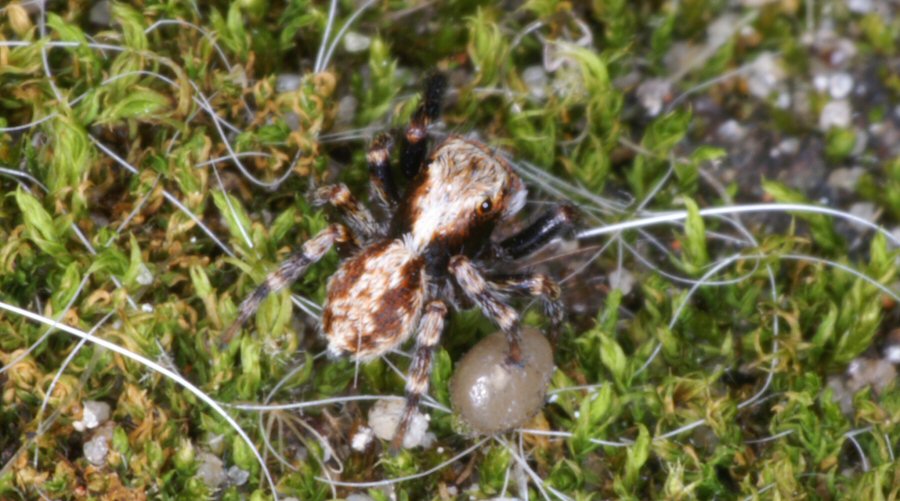 |
|
| Pseudeuophrys lanigera (was Euophrys lanigera) | |
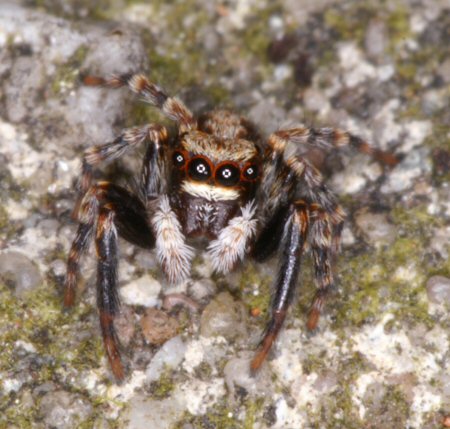 |
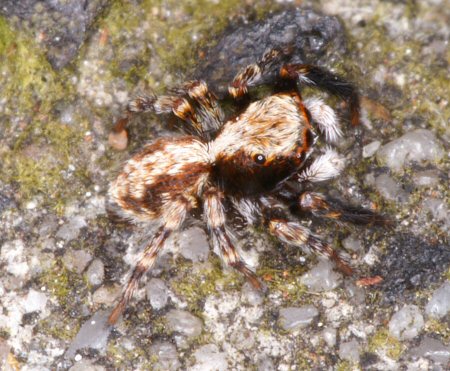 |
| Pseudeuophrys lanigera | Pseudeuophrys lanigera |
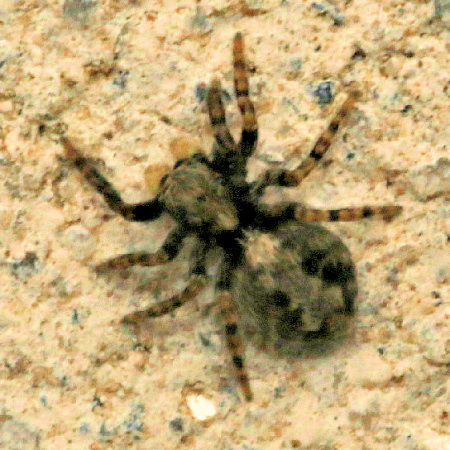 |
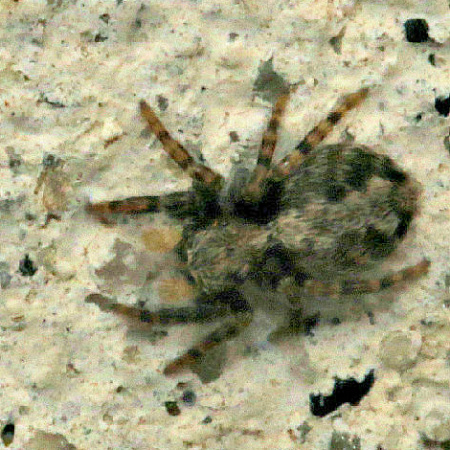 |
| Pseudeuophrys lanigera photo Eddie Barber | Pseudeuophrys lanigera photo Eddie Barber |
|
|
|
| Euophrys frontalis male and female (photo merged) | |
|
|
|
| Euophrys frontalis female | Euophrys frontalis male |
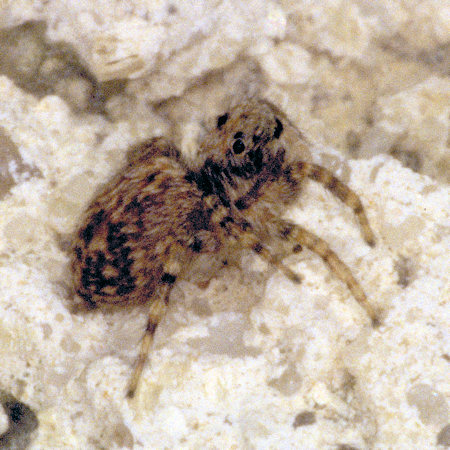 |
|
| Pseudeuophrys erratica | |
Genus Evarcha
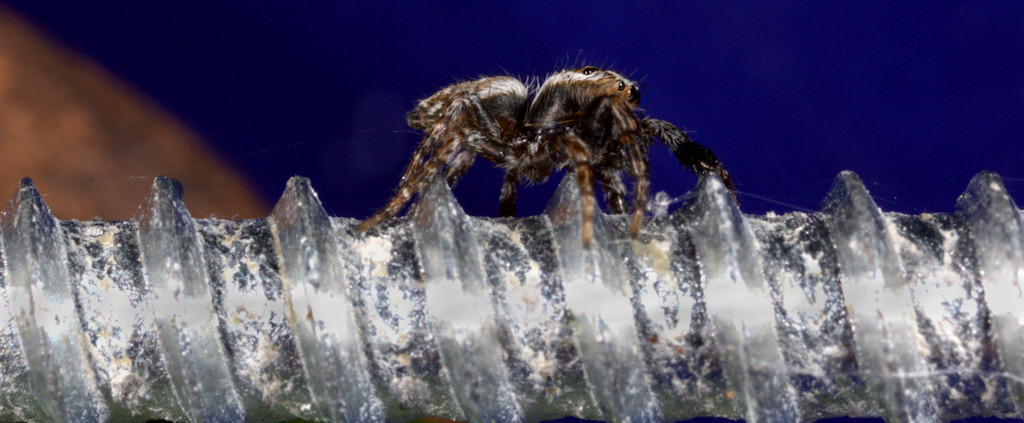 |
|
| Four species occur in Europe. The male is about 5 mm large while the female is about 7 mm. The body of the male has a deep black colour while the body of the female is brown and white. They live in dry meadows and forests. | |
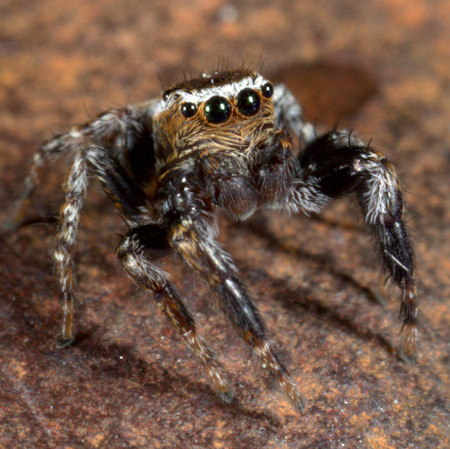 |
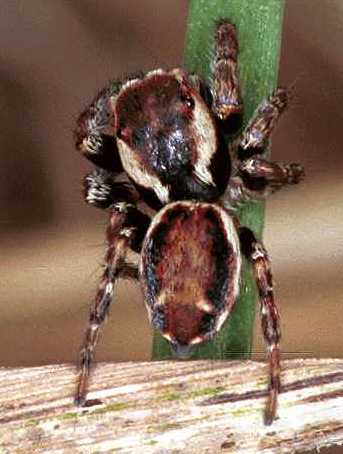 |
| Evarcha falcata male | Evarcha falcata male |
 |
|
| Evarcha falcata male jumps. Note: jumping spiders always jump with a lifeline attached to the origin of the jump (See right picture) | |
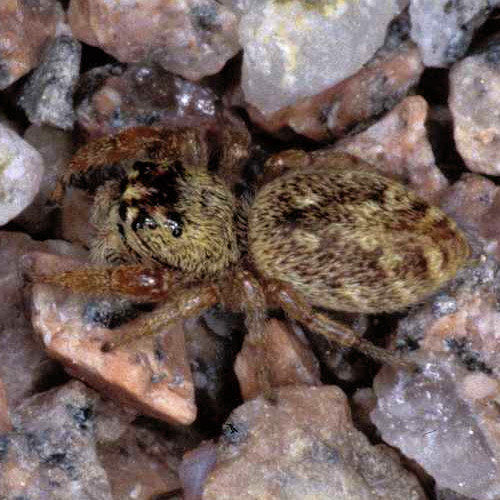 |
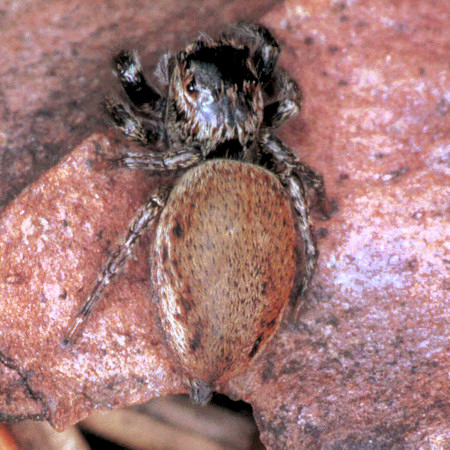 |
| Evarcha falcata female | Evarcha falcata female |
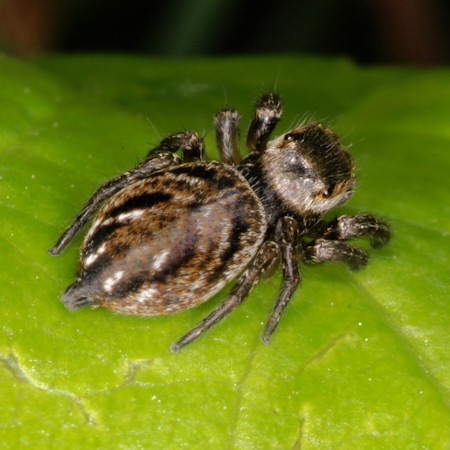 |
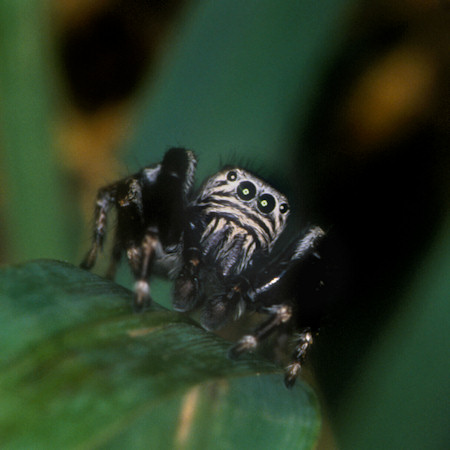 |
| Evarcha arcuata female | Evarcha arcuata male with its remarkable white lining on the forehead |
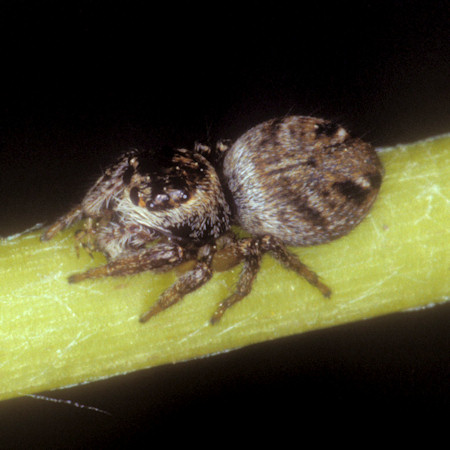 |
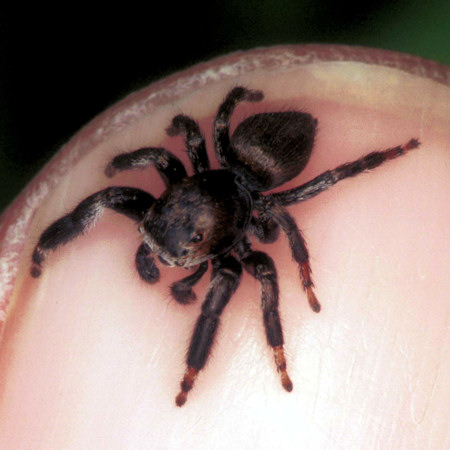 |
| Evarcha arcuata female | Evarcha arcuata male |
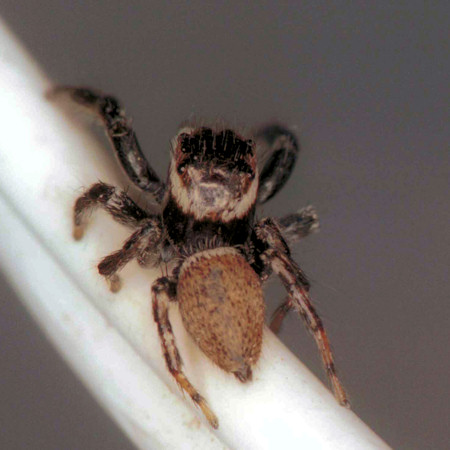 |
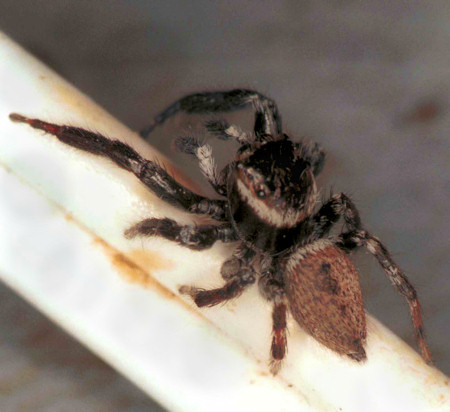 |
| Evarcha jacunda male | Evarcha jacunda male |
Genus Heliophanus
Eleven species can be found in NW-Europe. The female spider is easily recognized by the white stripe of hairs around the front of the abdomen. Their size varies between 3 and 6 mm. The majority of the species can be found on low vegetation.
|
|
|
|
|
Heliophanus kochii female |
Heliophanus kochii female |
Heliophanus kochii male |
|
|
|
|
Heliophanus cupreus male |
Heliophanus cupreus female |
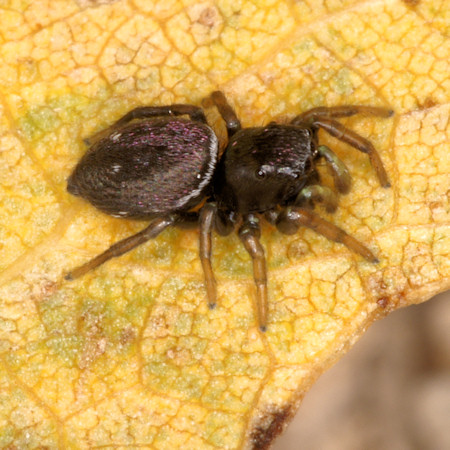 |
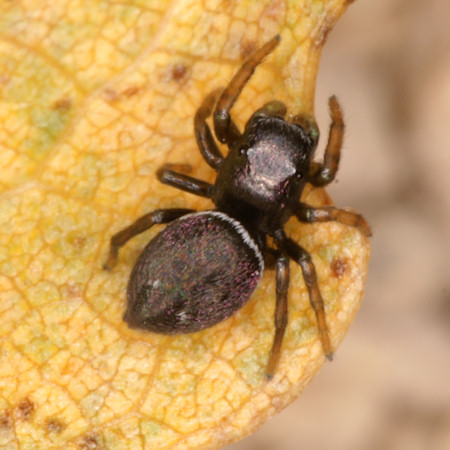 |
| Heliophanus aeneus female | Heliophanus aeneus female |
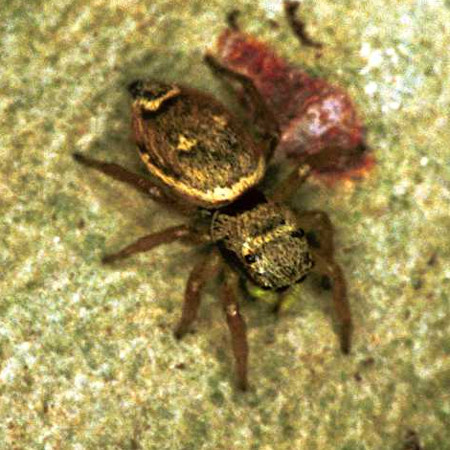 |
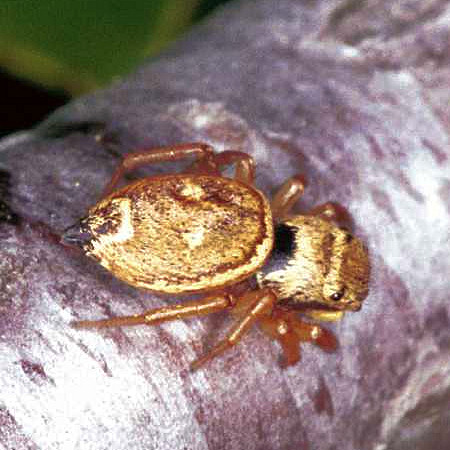 |
| Heliophanus tribulosus female | Heliophanus tribulosus female |
Genus Icius
This genus can be found in the Mediterranean region of NW-Europe.
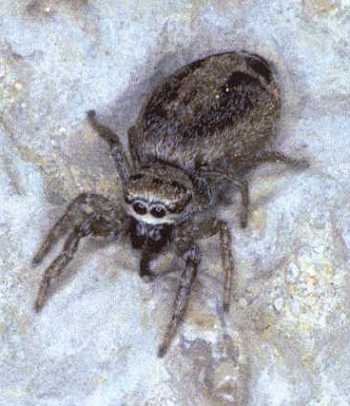
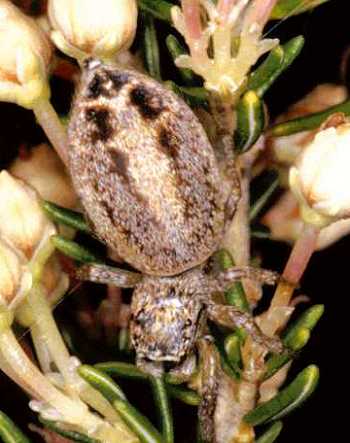 Icius
hamatus
female
Icius
hamatus
female
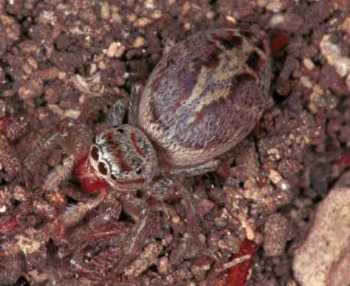
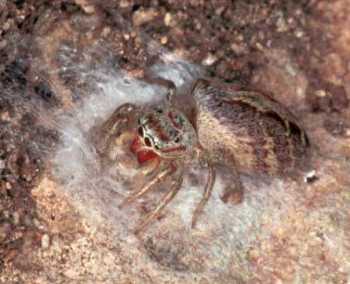 Icius
hamatus
male?
Icius
hamatus
male?
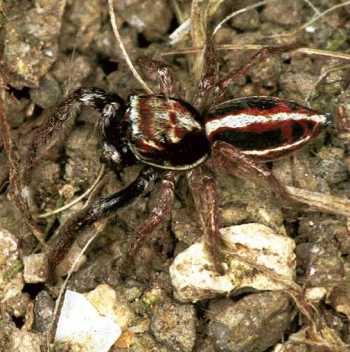
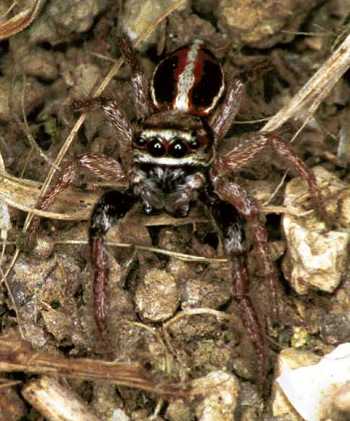 Icius
subinermis male
Icius
subinermis male
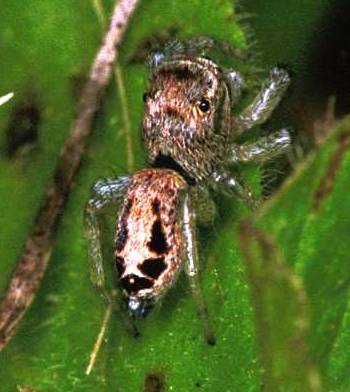 Icius
subinermis
female
Icius
subinermis
female
This genus Eris
is since 1992 placed in the genus
Macaroeris by
Wunderlich and are named after the Atlantic islands of
Macaronesia . Before that these spiders were placed in the genus
Dendryphantes.
Its size varies between 4 - 6 mm and she can be found
on branches of trees in the warmer parts of Europe, from the Canary Islands to
the Mediterranean region. Central Europe and eastwards to Central Asia.
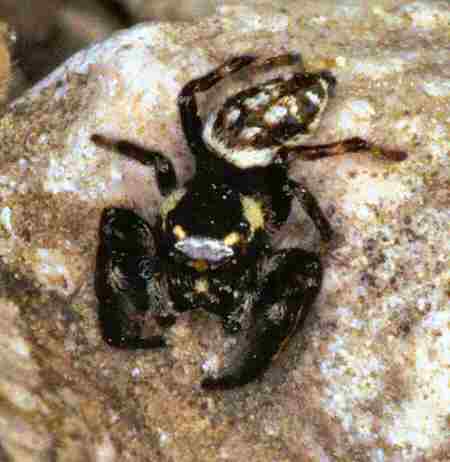 |
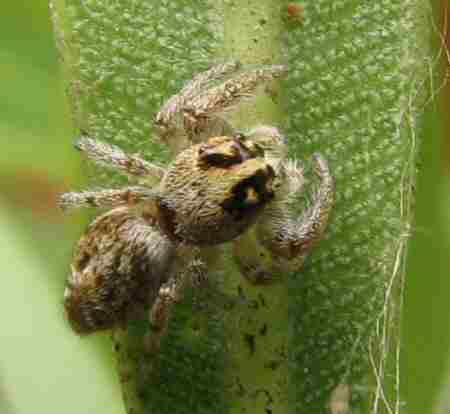 |
| Macaroeris nidicolens male | Macaroeris nidicolens female. picture by Danielle Ganzevoort. Spider found in Spijkenisse, the Netherlands 2006 |
Genus Marpissa
This spider is, with it size of 11 mm, one of the
largest jumping spiders. They all have an elongated abdomen.
Egg sacs are placed in a silken cell under bark,
stones or on vegetation and are guarded by the female.
Adult spiders can be found during summer and autumn
in forests. Five species can be found in NW-Europe.
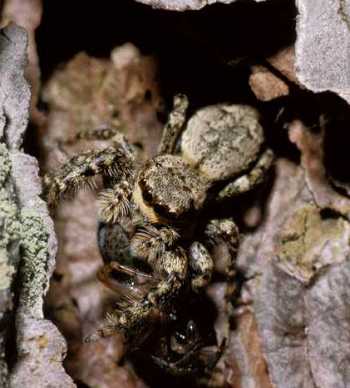
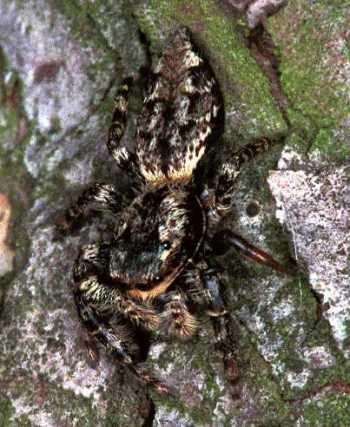 Marpissa
muscosa
female
Marpissa
muscosa
female
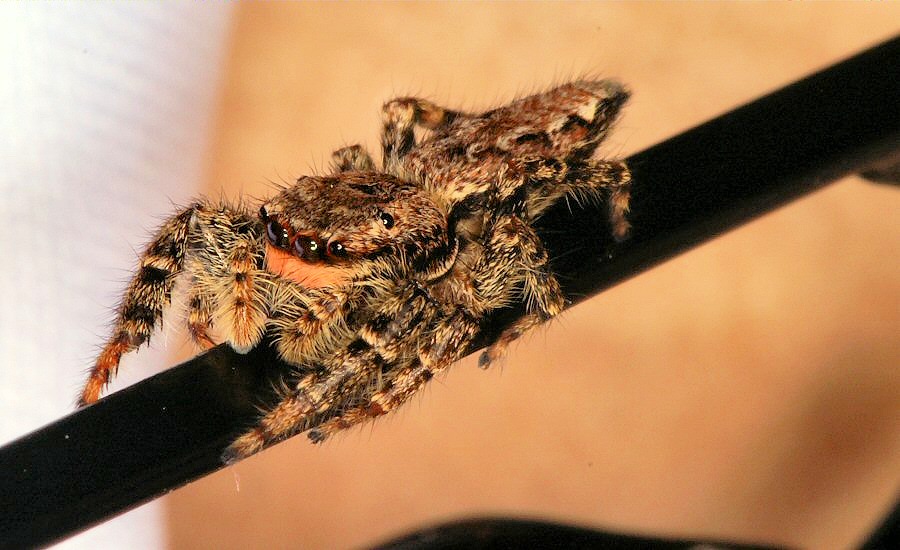
Marpissa muscosa female. Note the yellow band below the eyes
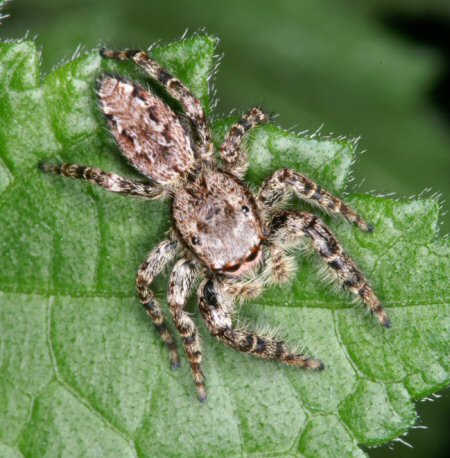
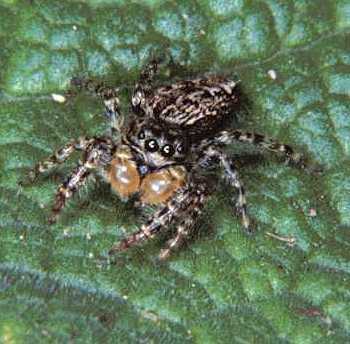 Marpissa
muscosa
sub adult male
Marpissa
muscosa
sub adult male
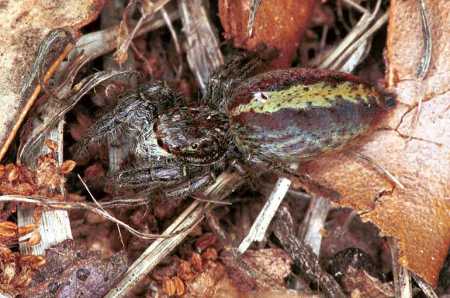
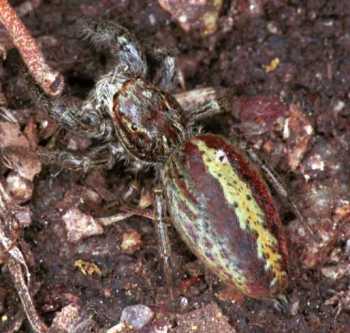 Marpissa
pomatia female
Marpissa
pomatia female
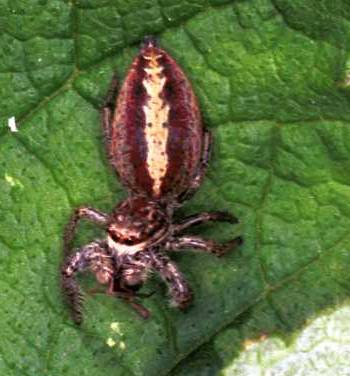 Marpissa
pomatia male
Marpissa
pomatia male
Genus Menemerus
This species is common in the
Mediterranean and
is absent in Middle- and North-Europe.
Their length varies between 7 and 9 mm. Males have
striking white haired pedipalps.
The spiders can be found on sunny walls and rocks
often in the surroundings of houses.
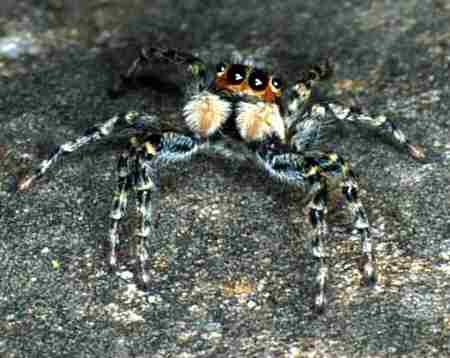 |
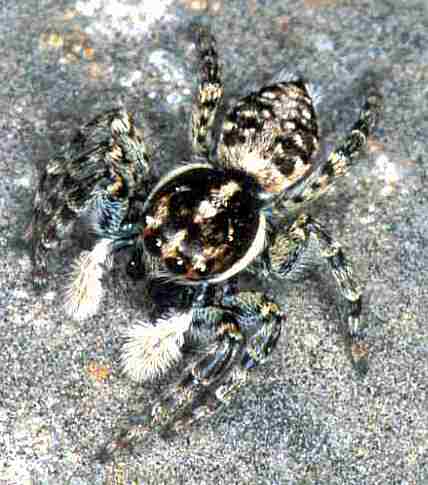 |
|
Menemerus semilimbatus
male |
Menemerus semilimbatus
male |
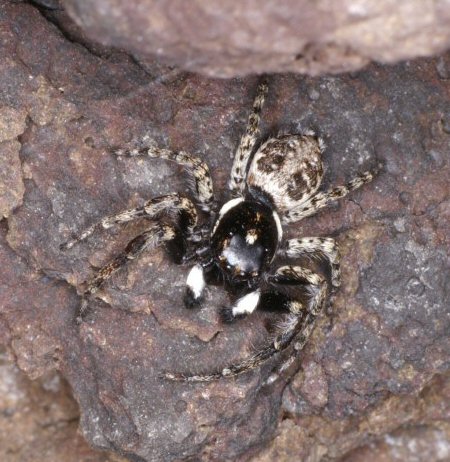 |
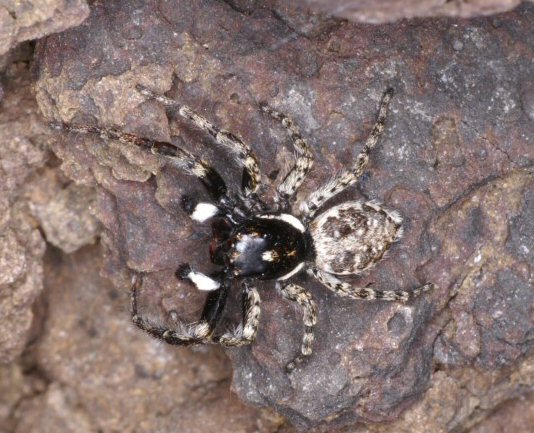 |
| Menemerus semilimbatus female | Menemerus semilimbatus female |
Genus Myrmarachne
Only one species occurs in NW-Europe. The size of
the fast moving spider is 5 - 6 mm and Myrmarachne can be found amongst stones
and low vegetation.
The body is brown and black. The male has remarkable
large chelicerae (jaws) and normal palps.
Spiders in this genus resembles and mimic the
behaviour of ants by waving their front legs to mimic antennae.
They live together with ants and are probably
protected because they wander between the ants and therefore avoid being eaten
by predators.
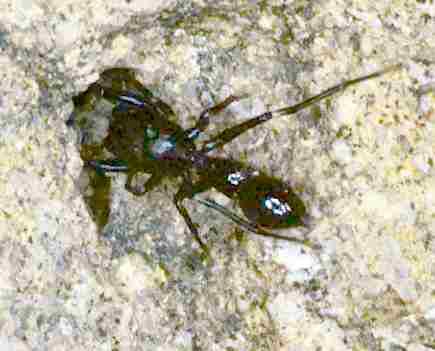 |
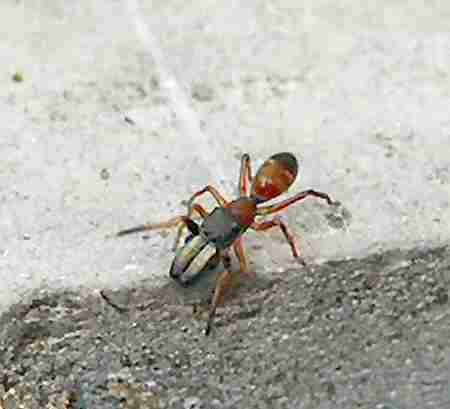 |
| Myrmarachne formicaria? female | Myrmarachne formicaria male (by Cor Kuipers) |
Genus Pellenes
Six species may be found in NW-Europe and can be found between leaf litter and on the bark of trees. Their size is 3 - 7 mm.
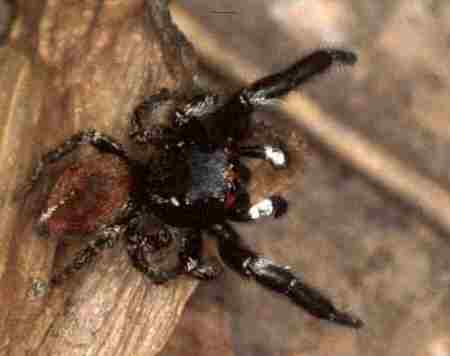 |
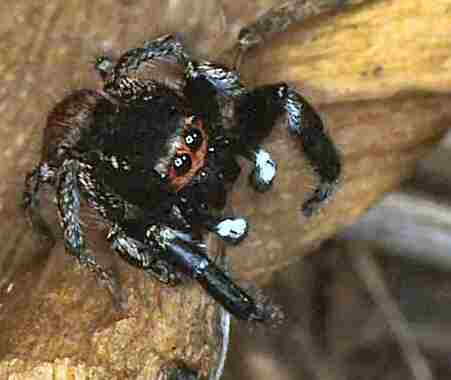 |
| Pellenes seriatus male | Pellenes seriatus male |
|
|
|
|
Pellenes arcigerus |
Pellenes nigrociliatus |
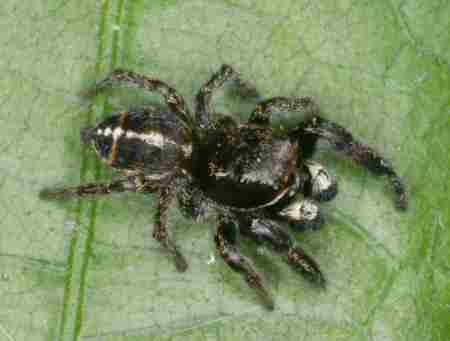 |
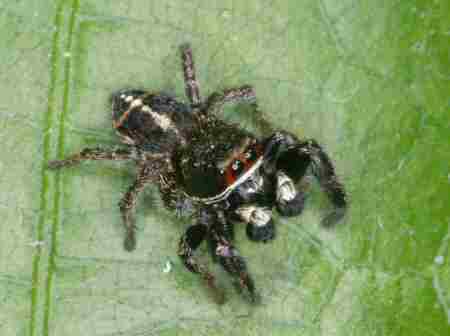 |
| Pellenes tripunctatus | Pellenes tripunctatus |
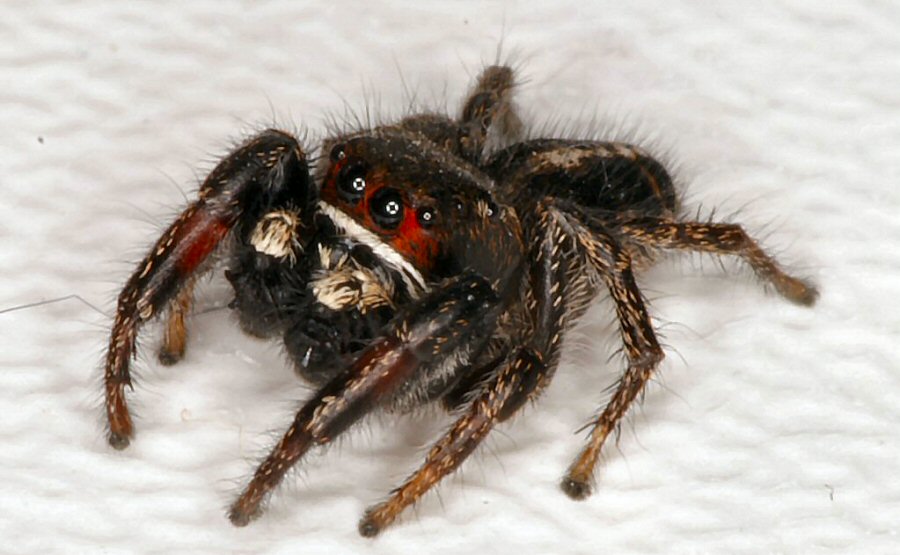 |
|
Genus Phlegra
Three species can be found in Europe. The spider measures 6 - 7 mm and can be found amongst low vegetation on sand hills and on shingle.
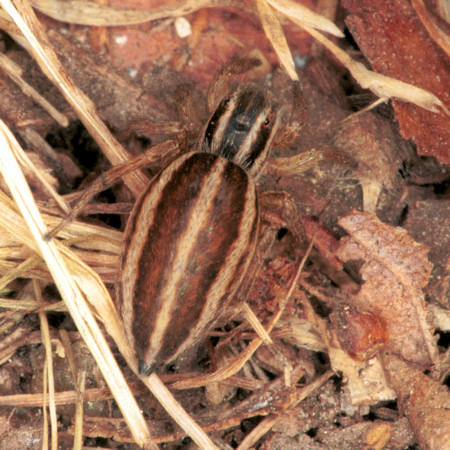 |
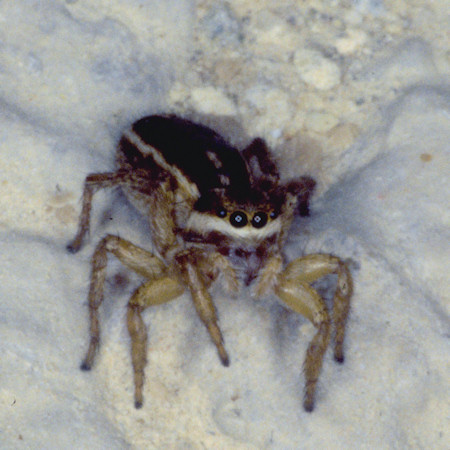 |
| Phlegra fasciata female | Phlegra fasciata female |
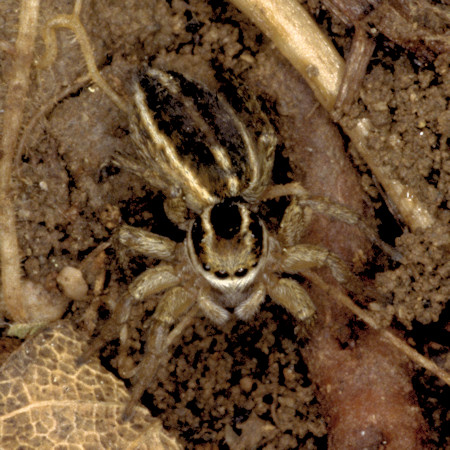 |
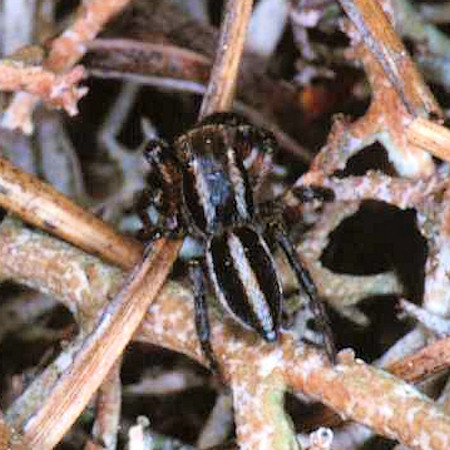 |
| Phlegra fasciata female | Phlegra fasciata male |
The only member in this genus in our region. The
male has a striking red abdomen. Their size is between 7 and 12 mm.
These spiders can be found between rocks, sometimes
at high altitudes in the southern part of Europe. The spider is rare.
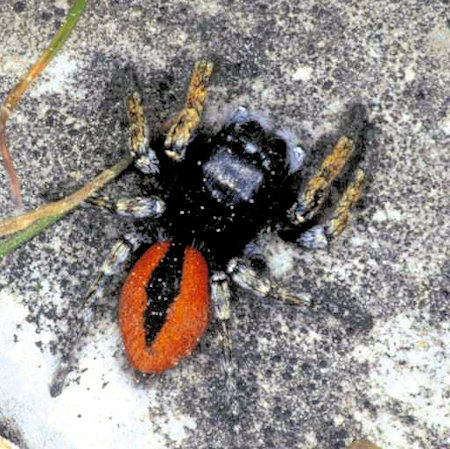 |
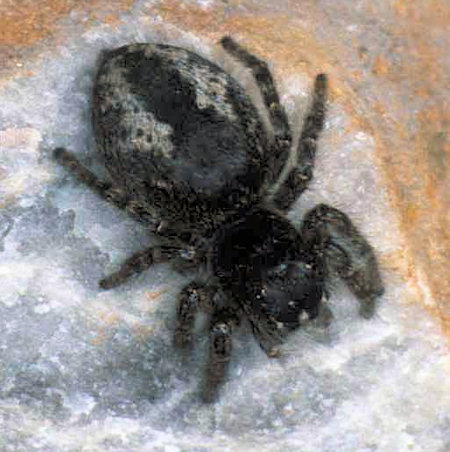 |
| Philaeus chrysops male | Philaeus chrysops female |
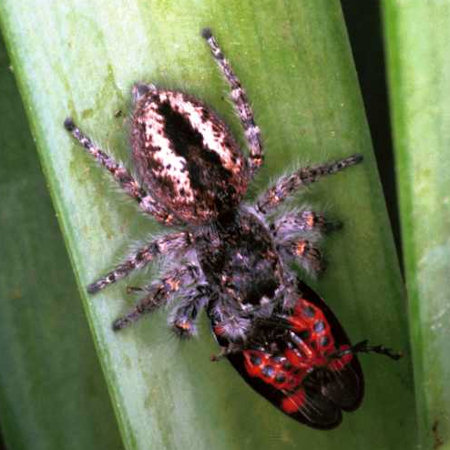 |
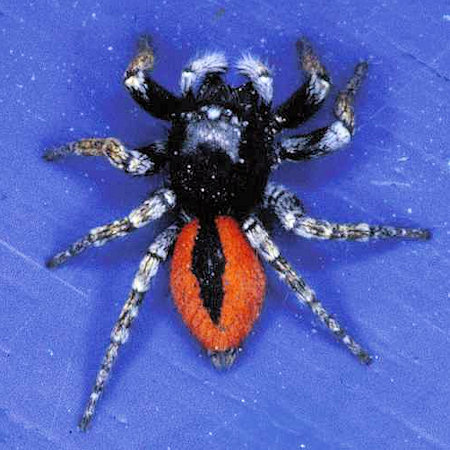 |
| Philaeus chrysops female | Philaeus chrysops male |
Genus Pseudicius
One species can be found in Europe. It resembles
Marpissa muscosa
but it is only half the size.
It can be found in woodland, amongst leaf-litter and
moss as well on the bark of trees. It size varies between 4.5 and 5.5 mm.
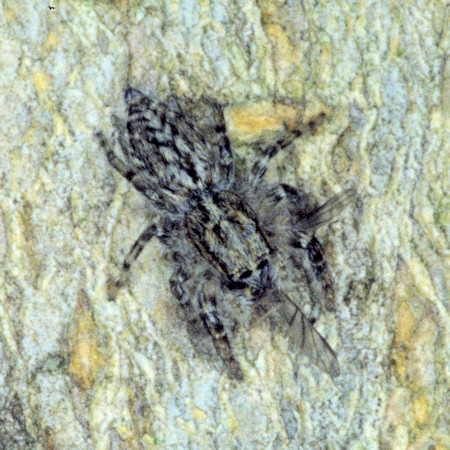 Pseudicius
encarpatus
Pseudicius
encarpatus
Genus Saitis
The male spider is remarkably beautiful with its
white tufted red painted third leg pair that he uses to attract female spiders.
See
courtship dance of
Saitis barbipes.
The size of the spider is 5 - 6 mm and can be found
around the Mediterranean on houses and rocks.
In Australië a spider with a similar courtship occurs, the peacock spider Maratus . Beside the waving of the third legd this spider sweeps uo iys abodomen that is coloured with sprectacular patterns and colourst.Both spider are described in this article, Peckhamia 74.1 Euophryine jumping spiders that extend their third leg.
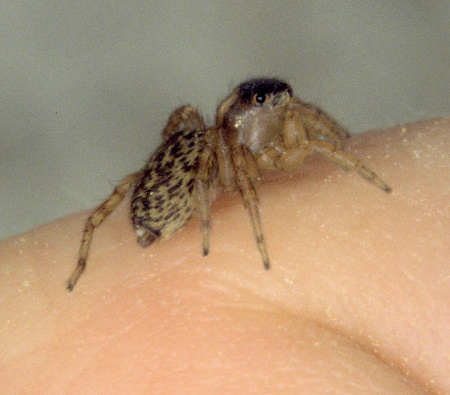 |
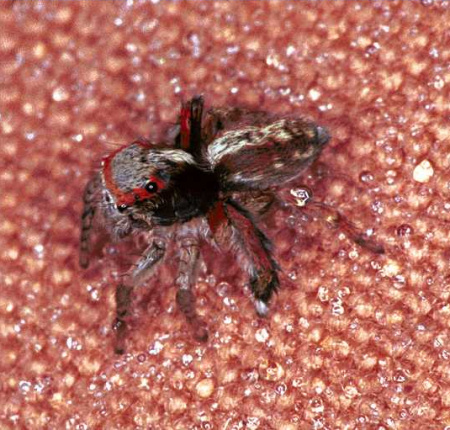 |
| Saitis barbipes vrouw | Saitis barbipes man |
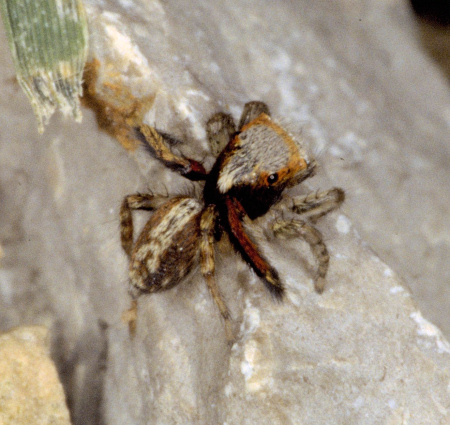 |
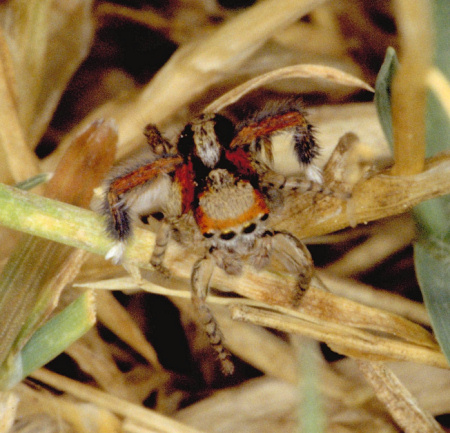 |
| Saitis barbipes man | Saitis barbipes man |
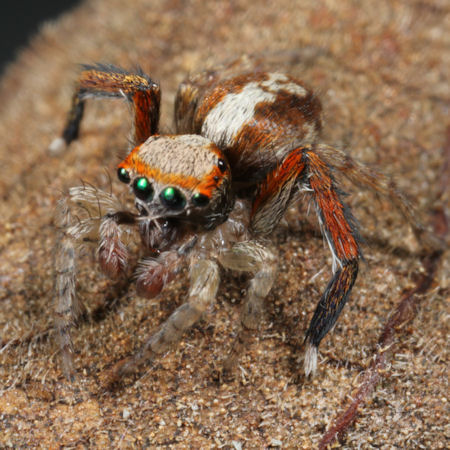 |
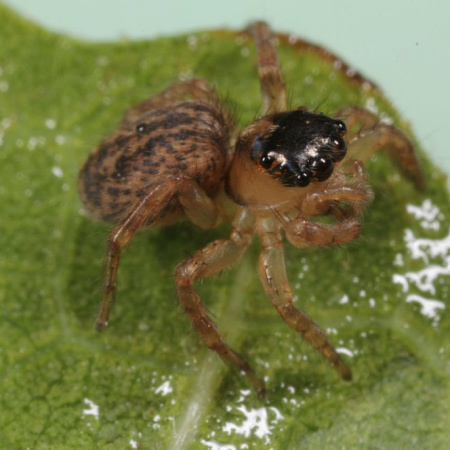 |
| Saitis barbipes man | Saitis barbipes vrouw |
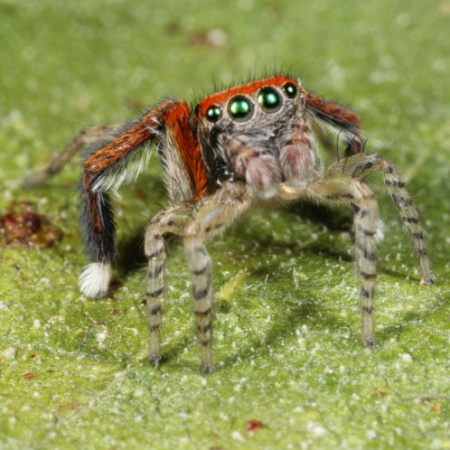 |
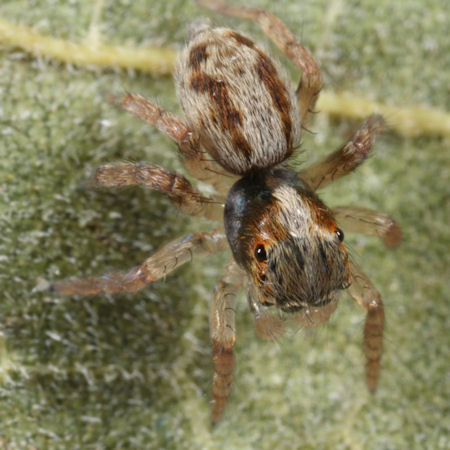 |
| Saitis barbipes man | Saitis barbipes jong |
Genus Salticus
Four species of salticus can be found. Salticus
scenicus is the most common one. Their size is
between 3 and 7 mm.
They are capable of catching large prey as can be
seen at the top of the page and below.
The common name of S.
scenicus is zebra spider.
Salticus scenicus
can be found on the walls of your house when the sun is shining.
Its size is between 5 -7 mm and it has a remarkable
white and black stripe pattern.
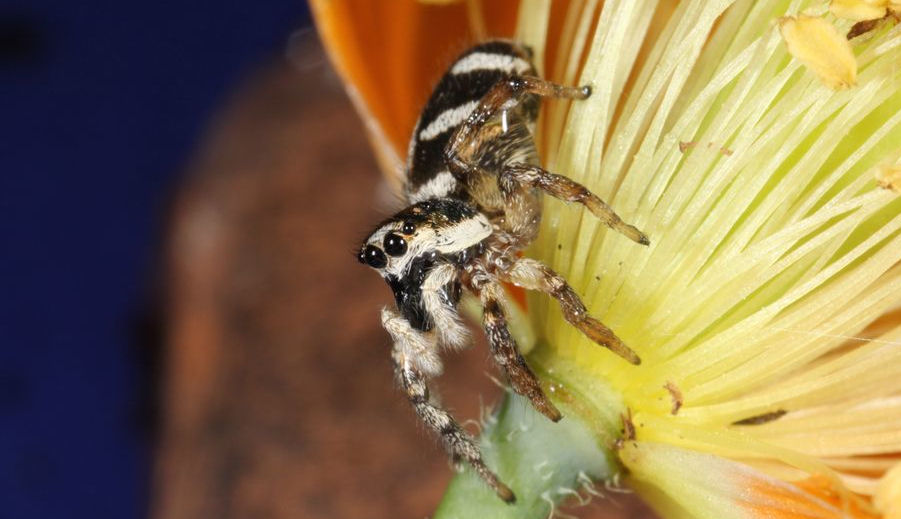 |
|
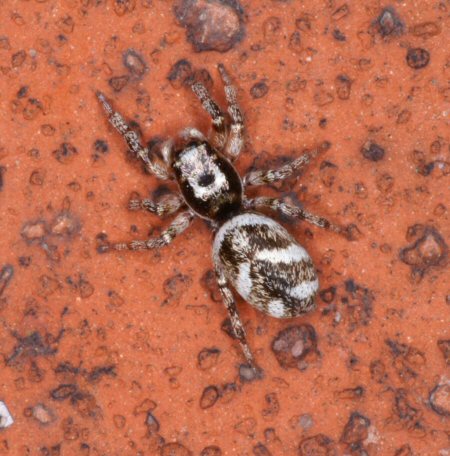 |
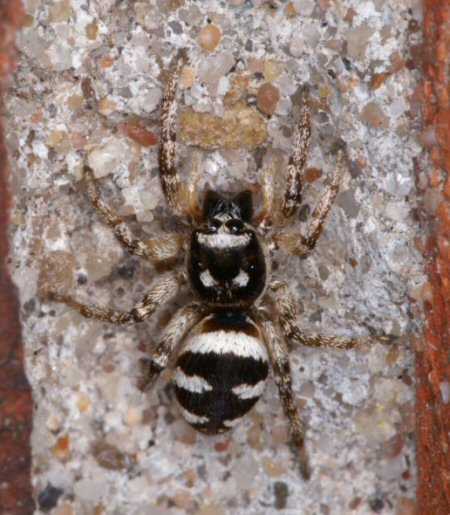 |
| .Salticus scenicus | .Salticus scenicus |
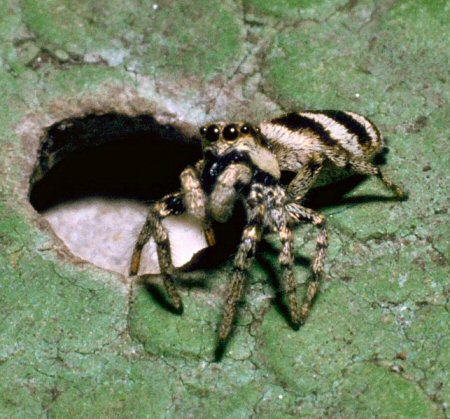 |
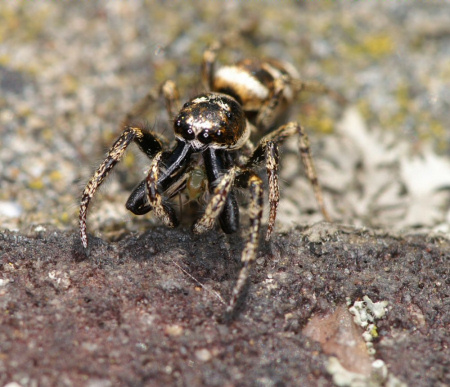 |
| .Salticus scenicus | .Salticus scenicus male (note is enormous fangs compared with thew female) |
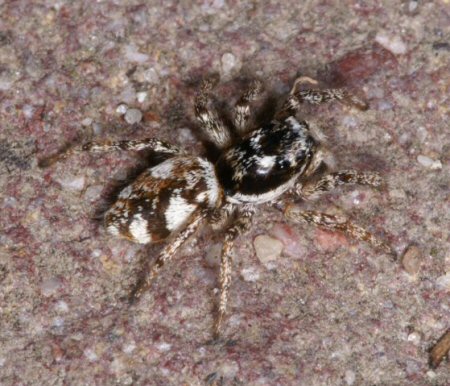 |
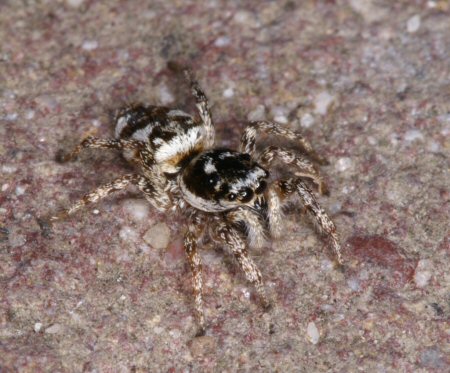 |
| Salticus zebraneus | Salticus zebraneus |
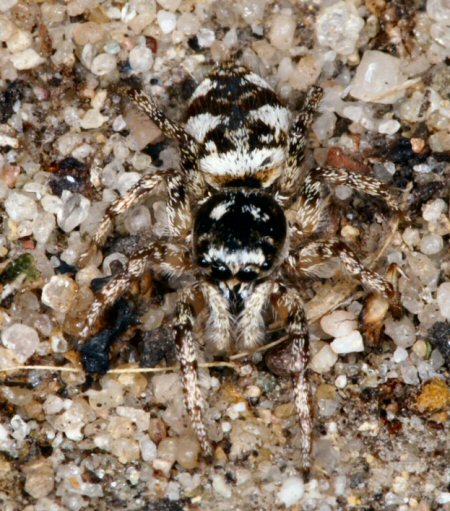 |
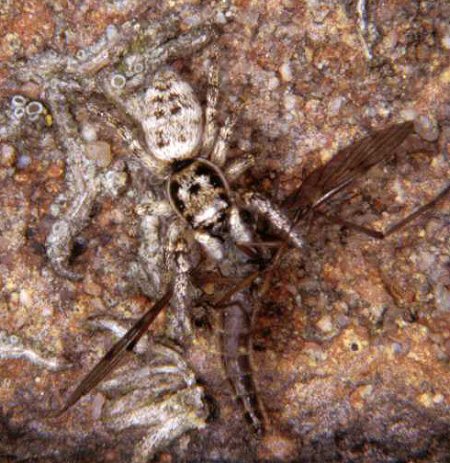 |
| Salticus zebraneus | Salticus cingulatus with prey |
Genus Sitticus
Thirteen species can be found in Europe. Their size varies between 4 - 8 mm.
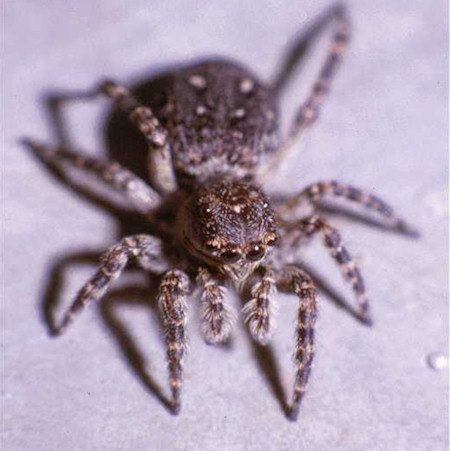 |
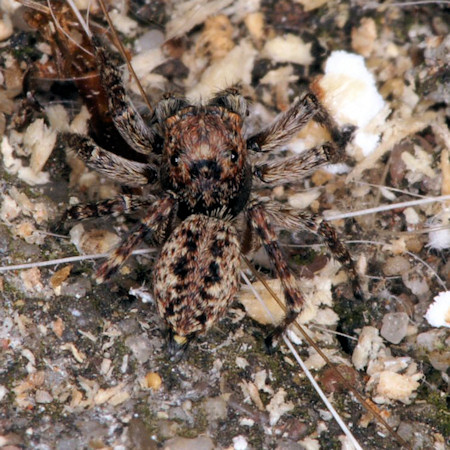 |
| Sitticus pubescens female | Sitticus pubescens |
|
|
|
|
Sitticus pubescens female |
Sitticus pubescens male |
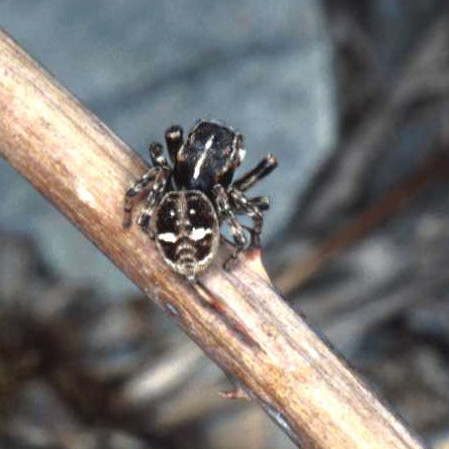 |
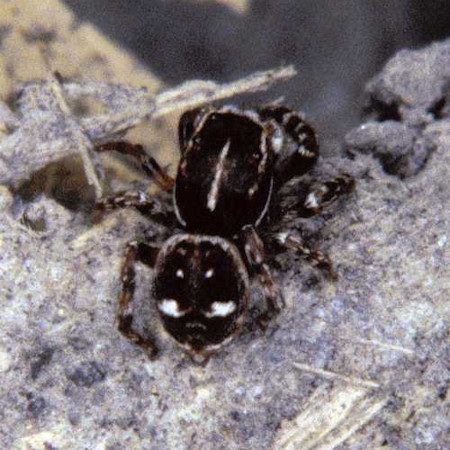 |
| Sitticus rupicola male | Sitticus rupicola male |
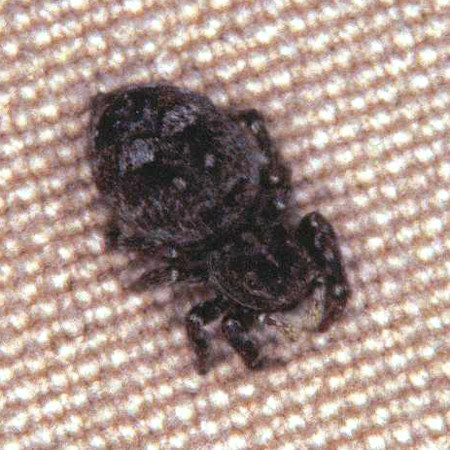 |
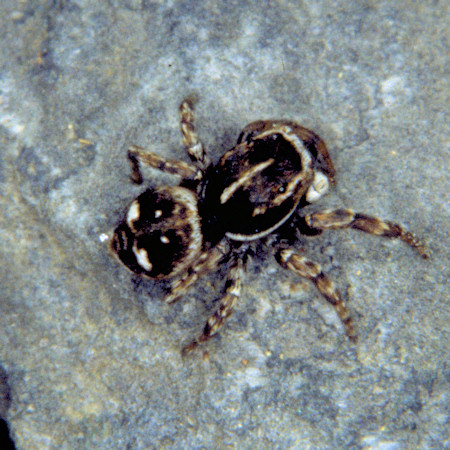 |
| Sitticus rupicola female | Sitticus rupicola male |
Ed Nieuwenhuys, 11 may 2022
3 march 2016, 7 february 2015 11 mei 2013, 10 January 2009, 12 november 2006, 21 juni 2006, 26 october 2005, 20 october 1996, 14 juli 1996